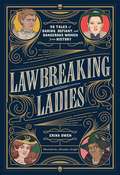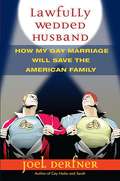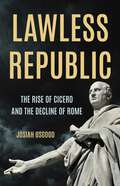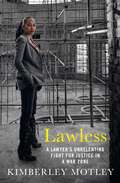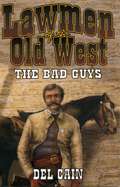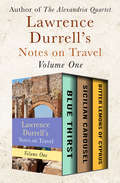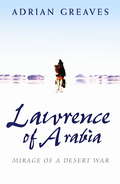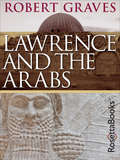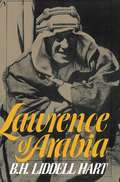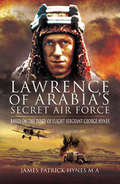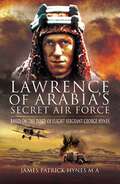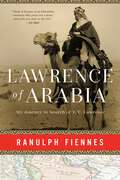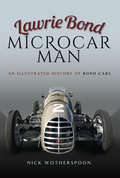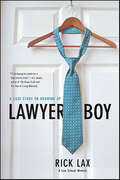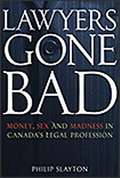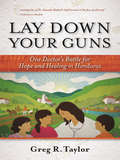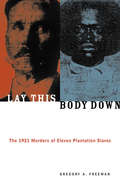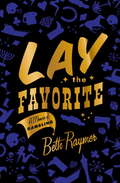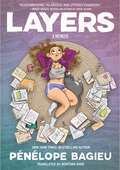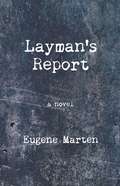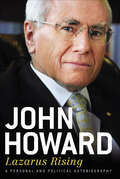- Table View
- List View
Law, Life, and the Teaching of Legal History: Essays in Honour of G. Blaine Baker
by Ian C. Pilarczyk, Angela Fernandez, and Brian YoungAs the leading legal historian of his generation in Canada and professor at McGill University for thirty-five years, Blaine Baker (1952–2018) was known for his unique personality, teaching style, intellectual cosmopolitanism, and deep commitment to the place of Canadian legal history in the curriculum of law faculties.Law, Life, and the Teaching of Legal History examines important themes in Canadian legal history through the prism of Baker’s career. Essays discuss Baker’s own research, his influence within McGill’s law faculty, his complex personality, and the relationship between the private and the public in the life of a university intellectual at the turn of the twenty-first century. Inspired by topics Baker took up in his own writing, contributors use Baker’s broad interests in legal culture to reflect on fundamental themes across Canadian legal history, including legal education, gender and race, technology, nation building and national identity, criminal law and marginalized populations, and constitutionalism.Law, Life, and the Teaching of Legal History offers a contemporary analysis of Canadian legal history and thoughtfully engages with what it means to honour one individual’s enduring legacy in the study of law.
Lawbreaking Ladies: 50 Tales of Daring, Defiant, and Dangerous Women from History
by Erika OwenDiscover 50 fascinating tales of female pirates, fraudsters, gamblers, bootleggers, serial killers, madams, and outlaws in this illustrated book of lawbreaking and legendary women throughout the ages.Many of us are familiar with the popular slogan &“Well-behaved women seldom make history.&” But that adage is taken to the next level in this book, which looks at women from the past who weren&’t afraid to break the law or challenge gender norms. From pirates to madams, gamblers to bootleggers, and serial killers to outlaws, women throughout the ages haven&’t always decided to be sugar, spice, and everything nice. In Lawbreaking Ladies, author Erika Owen tells the stories of 50 remarkable women whose rebellious and often criminal acts ought to solidify their place in history, including: - The swashbuckling pirate Ching Shih - &“Queen of the Bootleggers&” Gloria de Casares - The Prohibition-era gangster Stephanie Saint-Clair - And a band of prisoners who came to be known as the Goree Girls The perfect gift for true crime fans and lovers of little-known women&’s history, Lawbreaking Ladies serves as an engaging and informative guide to gals who were daring, defiant, and sometimes downright dangerous.
Lawfully Wedded Husband: How My Gay Marriage Will Save the American Family
by Joel DerfnerWhen Joel Derfner's boyfriend proposed to him, there was nowhere in America the two could legally marry. That changed quickly, however, and before long the two were on what they expected to be a rollicking journey to married bliss. What they didn't realize was that, along the way, they would confront not just the dilemmas every couple faces on the way to the altar--what kind of ceremony would they have? what would they wear? did they have to invite Great Aunt Sophie?--but also questions about what a relationship can and can't do, the definition of marriage, and, ultimately, what makes a family. <P> Add to the mix a reality show whose director forces them to keep signing and notarizing applications for a wedding license until the cameraman gets a shot she likes; a family marriage history that includes adulterers, arms smugglers, and poisoners; and discussions of civil rights, Sophocles, racism, grammar, and homemade Ouija boards--coupled with Derfner's gift for getting in his own way--and what results is a story not just of gay marriage and the American family but of what it means to be human.
Lawless Republic: The Rise of Cicero and the Decline of Rome
by Josiah OsgoodA historian of Rome &“at the height of his powers&” (Barry Strauss, author of The War That Made the Roman Empire) narrates the erosion of law and order in the last years of the Roman Republic through the rise and fall of its most famous lawyer, Cicero In its final decades, the Roman Republic was engulfed by a crime wave. An epidemic of extortions, murders, and acts of insurrection tested the court system&’s capacity to maintain order. As case after case filled the docket, an ambitious young lawyer named Cicero seized every opportunity to litigate, forging a reputation as a master debater with a bright future in politics. In Lawless Republic, historian Josiah Osgood recounts the legendary orator&’s ascent and fall, and his pivotal role in the republic&’s lurch toward autocracy. Cicero&’s first appearance in the courts came shortly after the end of a brutal civil war. After leveraging his fame as a lawyer to become a consul, he ruthlessly crushed a coup by suppressing the liberties of Roman citizens. The premiere legal mind of Rome came to argue that the pursuit of a higher justice could sometimes justify sweeping the law aside, laying the groundwork for Roman history&’s most famous act of political violence—the assassination of Julius Caesar. Lawless Republic vividly resurrects the spectacle of the courts in the time of Cicero and Caesar, showing how politics trumped the rule of law and sealed the fate of Rome.
Lawless: A Lawyer's Unrelenting Fight for Justice in a War Zone
by Kimberley MotleyIn the summer of 2008 Kimberley Motley quit her job as a public defender in Milwaukee to join a program that helped train lawyers in war-torn Afghanistan. She was 32 at the time, a mother of three who had never traveled outside the U.S. What she brought to Afghanistan was a toughness and resilience which came from growing up in one of the most dangerous cities in the country, a fundamental belief in everyone's right to justice, and an unconventional legal mind that has made her a legend in an archaic, misogynistic, and deeply conservative environment. Through sheer force of personality, ingenuity and perseverance, Kimberley became the first foreign lawyer to practice in Afghanistan and her work swiftly morphed into a mission—to bring "justness" to the defenseless and voiceless. She has established herself as an expert on its fledgling criminal justice system, able to pivot between the country's complex legislation and its religious laws in defense of her clients. Her radical approach has seen her successfully represent both Afghans and Westerners, overturning sentences for men and women who've been subject to often appalling miscarriages of justice. Inspiring and fascinating in equal measure, Lawless tells the story of a remarkable woman operating in one of the most dangerous countries in the world.
Lawmen of the Old West: The Bad Guys
by Del CainSome of the law officers who served the West during the last half of the nineteenth century drifted from one side of the law to the other and sold their talents to whichever side offered the most advantage. Others used their positions as cover for their criminal activities. The lawmen in this book were serious offenders against the laws they had at one time sworn to uphold. Their skills were honed in range wars and family feuds and polished along the cattle trails, in the saloons and banks, and on the trains of the West. Some of them did good work enforcing the law when that was their job. Others had equally successful careers on the other side of the law. More than one kicked out their lives at the end of ropes strung up by citizens who were outraged by their abuse of the trust that went along with the badge they wore. These are their stories.
Lawrence Durrell's Notes on Travel Volume One: Blue Thirst, Sicilian Carousel, and Bitter Lemons of Cyprus
by Lawrence DurrellTravel writing &“as luminous as the Mediterranean air&” from the acclaimed author of the Alexandria Quartet, who is featured in PBS&’s The Durrells in Corfu (Time). Born in India, acclaimed British novelist and poet Lawrence Durrell lived in Corfu as a young man, enjoying salt air, cobalt water, and an unfettered bohemian lifestyle, along with his brother, Gerald, who would also go on to be a writer and a naturalist. Their real-life family is portrayed in the PBS Masterpiece production, The Durrells in Corfu. Over the following decades, he rambled around the Mediterranean, making homes in Egypt, Cyprus, and Greece, always bringing his poet&’s eye to document his experiences. Blue Thirst: In the first of a pair of lectures, given during a 1970s visit to California, Durrell recalls his family&’s time living on the Greek island of Corfu, expanding on his eloquent memoir, Prospero&’s Cell. When the Second World War came to the Mediterranean, Durrell was swept into diplomatic service, an adventure he vividly recounts in his powerful second lecture. &“[Durrell&’s] travel books arrive like long letters from a civilized and very funny friend.&” —Time Sicilian Carousel: For years, Durrell&’s friend Martine had begged him to visit her on the sun-kissed paradise of Sicily, but it took her sudden death to finally bring him to the island&’s shores. With Martine&’s letters in his pocket, Durrell treks from sight to sight, dizzy with history and culture, and finds haunting echoes of his past lives in Rhodes, Cyprus, and Corfu. &“Elegant . . . wonderful.&” —Time Bitter Lemons of Cyprus: Against the backdrop of the push for independence on Cyprus in the early 1950s, the poet, novelist, and former British government official buys a house, secures a job, and settles in, yearning for a return to the island lifestyle of his youth. Winner of the Duff Cooper Prize, this memoir is an elegant picture of island life in a changing world. &“Brilliant depth of language . . . gathering slowly from the lighter delightful pages to its lost and questioning end. Never for a moment does [Durrell] lose the poet&’s touch.&” —The New York Times
Lawrence Grassi
by Gabriele Scardellato Elio CostaLawrence Grassi was a trailblazer in every sense of the word. A working-class man of humble Italian origins who worked as a labourer and a coal miner for most of his life, Grassi had a deep passion for the Rocky Mountains. He was famous in the region for his commitment as a guide, a mountain climber, and a builder of greatly admired hiking trails. Today, in or near Canmore, his name graces a mountain, two lakes, and a school, and he is commemorated at Lake O'Hara in Yoho National Park.In Lawrence Grassi: From Piedmont to the Rocky Mountains, Elio Costa and Gabriele Scardellato uncover the deeply private man behind this legend, from his birth in the small Italian village of Falmenta to his long and inspirational career in Canada. Using previously unexamined family letters and extensive information on Grassi's cohort of Italian immigrants, the authors reconstruct his personal and professional life, correcting myths and connecting his story to the long history of Italian immigration to Canada. The definitive biography of this Canadian mountain hero, Lawrence Grassi will be essential reading for those interested in the history of immigration, sport, and the Rocky Mountains.
Lawrence Of Arabia: Mirage Of A Desert War
by Adrian GreavesA new biography of Lawrence of ArabiaT.E. Lawrence is one of the most enigmatic characters in British history. At the outbreak of the First World War he was working as an archaeologist in the Middle East. He had no military training at all, and a strong distrust of politicians and senior officers alike. And yet he succeeded in a task where all these people had failed: not only did he unite the Arab nation - a nation at perpetual war with itself - but he also led them to victory against the Ottoman Empire.How he managed to achieve these incredible feats has fascinated and confounded historians ever since. The myths that have grown up around this remarkable man have been enhanced by the untruths Lawrence himself propagated. He was never captured and tortured by the Turks as he claimed, neither was he the first to target Ottoman troops by dynamiting their trains. And yet the truth is every bit as compelling as the fiction. He was far more ruthless than he portrayed himself, and the battles he fought were every bit as barbarous as those fought by his Ottoman enemies. He was also strangely determined not to take credit for his achievements: when offered the VC at Buckingham Palace he refused it, leaving the king holding the box.This brand new biography by the author of RORKE'S DRIFT uses primary sources to uncover the truth from all the fictions that surround this legendary man. It covers the actualities of the war Lawrence fought in greater detail than ever before, and also describes what happened to Lawrence after the war.
Lawrence Of Arabia: Mirage Of A Desert War
by Adrian GreavesA new biography of Lawrence of ArabiaT.E. Lawrence is one of the most enigmatic characters in British history. At the outbreak of the First World War he was working as an archaeologist in the Middle East. He had no military training at all, and a strong distrust of politicians and senior officers alike. And yet he succeeded in a task where all these people had failed: not only did he unite the Arab nation - a nation at perpetual war with itself - but he also led them to victory against the Ottoman Empire.How he managed to achieve these incredible feats has fascinated and confounded historians ever since. The myths that have grown up around this remarkable man have been enhanced by the untruths Lawrence himself propagated. He was never captured and tortured by the Turks as he claimed, neither was he the first to target Ottoman troops by dynamiting their trains. And yet the truth is every bit as compelling as the fiction. He was far more ruthless than he portrayed himself, and the battles he fought were every bit as barbarous as those fought by his Ottoman enemies. He was also strangely determined not to take credit for his achievements: when offered the VC at Buckingham Palace he refused it, leaving the king holding the box.This brand new biography by the author of RORKE'S DRIFT uses primary sources to uncover the truth from all the fictions that surround this legendary man. It covers the actualities of the war Lawrence fought in greater detail than ever before, and also describes what happened to Lawrence after the war.
Lawrence and the Arabs (Biblioteca Breve Ser.)
by Robert GravesThe real story of T. E. Lawrence&’s life as told by the author of I, Claudius. &“A combination of history, biography, and . . . an amazingly human tale&” (Boston Evening Transcript). Immortalized in the film Lawrence of Arabia, the real T. E. Lawrence was a leader, a war strategist, and a scholar, and is here immortalized in an intimate biography written by his close friend, the award-winning British novelist, poet and classicist Robert Graves. As a student at Oxford, T. E. Lawrence was fascinated with Middle Eastern history and culture, and underwent a four-month visit to Syria to study the fortifications built by the crusaders. Later, he returned to the region, this time as an archaeologist working with the British Army&’s Intelligence unit in Egypt during World War I. From there, in 1916, he joined Arab rebels fighting against Turkish domination. His brilliance as a desert war tactician earned him the respect of the Turkish fighters and worldwide renown. &“Interesting and informative.&” —New York Herald Tribune &“[Mr. Graves] has done his job admirably and without any too obvious excesses of hero worship.&” —New Statesman &“[Readers] will consult Mr. Graves for information about this man.&” —The New Republic
Lawrence of Arabia
by B. H. Liddell HartT. E. Shaw, better known as Lawrence of Arabia, was one of the most romantic, heroic, and enigmatic figures of his day. The subject of myth and hagiography, he was equally accomplished in several fields-as archaeologist, diplomat, writer, and soldier-and he worked throughout World War I and after in the Middle East in efforts to promote independent Arab states. His autobiography Seven Pillars of Wisdom is one of the greatest works of its kind. The esteemed military historian B. H. Liddell Hart wrote this study of Lawrence in order to pierce the clouds of legend. He discussed Lawrence's Oxford days, his experiences as an intelligence officer in Egypt, and in particular the tactics of guerrilla warfare he practiced so effectively against the large Turkish armies during World War I. Liddell Hart was one of the few to give Lawrence his full justice as both a man and a brilliant soldier. Long out-of-print, this book unravels the many puzzling features of Lawrence's story and restores him to his proper place as one of the twentieth century's heroic, but very human, figures.
Lawrence of Arabia's Secret Air Force: Based on the Diary of Flight Sergeant George Hynes
by James Patrick HynesX Flight was designated the task of giving close air support to the desert army formed and commanded by Lawrence of Arabia. It flew from advanced desert landing grounds on reconnaissance, liaison, bombing and ground attack missions. The existence and deeds of the flight were kept secret, so much so that even the RFC Paymaster was unaware of their existence.George Hynes was an aircraft mechanic and became responsible for keeping the flights somewhat elderly aircraft airworthy whilst working in the most difficult desert conditions on hastily constructed landing strips and living and working under canvas in temperatures that froze at night and rose to 100 degrees plus at noon.His diary gives a clear insight into the conditions endured, the actions that took place and the many almost insurmountable problems that occurred as they followed Lawrences steady advance against the numerically superior Turkish Army and Air Force. George personally encountered Lawrence on many occasions and maintained contact with him after the war.The diary is supported with the Flights weekly operational records, perspectives of the battle scenarios and other background information.
Lawrence of Arabia's Secret Air Force: Based on the Diary of Flight Sergeant George Hynes
by James Patrick HynesX Flight was designated the task of giving close air support to the desert army formed and commanded by Lawrence of Arabia. It flew from advanced desert landing grounds on reconnaissance, liaison, bombing and ground attack missions. The existence and deeds of the flight were kept secret, so much so that even the RFC Paymaster was unaware of their existence.George Hynes was an aircraft mechanic and became responsible for keeping the flights somewhat elderly aircraft airworthy whilst working in the most difficult desert conditions on hastily constructed landing strips and living and working under canvas in temperatures that froze at night and rose to 100 degrees plus at noon.His diary gives a clear insight into the conditions endured, the actions that took place and the many almost insurmountable problems that occurred as they followed Lawrences steady advance against the numerically superior Turkish Army and Air Force. George personally encountered Lawrence on many occasions and maintained contact with him after the war.The diary is supported with the Flights weekly operational records, perspectives of the battle scenarios and other background information.
Lawrence of Arabia: My Journey in Search of T. E. Lawrence
by Ranulph FiennesA vivid and illuminating biography of the famed T. E. Lawrence, written by &“the world's greatest living explorer,&” Ranulph Fiennes.As a young British intelligence officer in Cairo, archaeologist and adventurer Thomas Edward Lawrence became involved in the 1916 Arab Revolt, fighting alongside rebel forces against the Ottomans. He made a legendary 300-mile journey through blistering heat; he wore Arab dress; and he strongly identified with the people in his adopted lands. By 1918, he had a £20,000 price on his head. Despite readers' long fascination in his story, Lawrence—one of history's most enigmatic adventurers—has long remained unknowable, But with in-depth knowledge of what it takes to venture into the unknown, this authoritative biography from famed explorer Ranulph Fiennes at last brings enthralling insight and clarity to this remarkable life.
Lawrie Bond, Microcar Man: An Illustrated History of Bond Cars
by Nick WotherspoonOnce a common sight on Britain's roads, few people today seem to have heard of the Bond Minicar not a diminutive, gadget laden conveyance for the fictional 007 character, but a popular, practical, motorcycle-engined, three-wheeler that in the post-war austerity period, gave tens of thousands of people affordable personal transport at a time when conventional vehicles were beyond the reach of the average household. Yet whilst the later, mostly imported, 'Bubble cars' have remained in the public eye, it is largely forgotten that the first of the postwar 'Microcars' to go into significant production was the British designed and built Bond. Equally enigmatic seems to be the designer of this vehicle, Lawrence 'Lawrie' Bond a prolific automotive design genius, with a penchant for weight-saving construction techniques. He was responsible for a wide range of two, three and four wheel vehicles; from ultra-lightweight motorcycles and scooters, such as the Minibyke, Lilliput and Gazelle, as well as his other Microcars the stylish Berkeley and perhaps less-than-pretty Opperman Unicar and finally to his later work, including the innovative, but troubled Bond 875 and styling the Equipe GT sportscar.Here the story is told in full, covering all Lawrie's innovative designs and the various vehicles that bore his name, all in prolifically illustrated detail, together with his passion for motor racing, which resulted in a number of technically acclaimed racing cars, some of which can still be seen competing is historic racing events today.
Lawyer Boy: A Case Study on Growing Up
by Rick LaxAfter college, Rick Lax moved back into his parents' house. The closest thing he had to a job was eating his parents' food, sitting on his parents' couch, and watching The Price is Right. An amateur magician, he spent the rest of his time practicing card tricks and rope tricks. And though he could tie four different slipknots, the necktie posed some difficulties.Rick's father, a successful Michigan attorney, told Rick it was time to move out and enter the real world. Rick certainly wasn't going to get a job, so he went to law school instead.This is the story of Rick's journey from childhood to lawyerhood.In Lawyer Boy, Rick uses the skills he developed as a magician to succeed in class, and learns how to become a lawyer without becoming his father. His journey through law school was exhausting, exciting, and infuriating, and, the way he tells it, so funny it's criminal.
Lawyers Gone Bad
by Philip SlaytonIn this shocking and delicious expose, Philip Slayton, a respected corporate lawyer and former dean of law, sheds light on those who betrayed clients and committed crimes-sometimes for very little personal gain. While recounting actual cases of Canadian lawyers who ran afoul of the law, using one-on-one interviews with the offenders and their families, Slayton searches for what drives a respected professional to corruption. Sharp and insightful, this book is a call for reform of the legal profession as well as an entertaining, eyebrow-raising look at the few who give lawyers a bad name.
Lay Down Your Guns: One Doctor's Battle for Hope and Healing in the Honduran Wild West
by Greg TaylorHow does Dr. Amanda Madrid's faith help her overcome violence and fear after dangerous drug cartels attack the jungle clinics she has established? How will she achieve her desire to bring hope and healing to the wounded and suffering people in the mountains of Central Honduras?In Honduras' "Wild West" mountain jungles, Amanda Madrid found her calling as a medical doctor to poor farmers.When she was a young girl, Amanda prayed a prayer asking God to help her serve the rest of her life as a doctor. When her father rejected her dream and calling, eighteen- year-old Amanda struck out alone to enter medical school in Tegucigalpa, Honduras.Her work as a medical officer, international consultant, and director of a multi- national Christian medical group called Predisan could have resulted in prestigious luxury for her. Instead, she became a medical missionary in her own country; her faithfulness to her prayer as a little girl led Dr. Madrid to the mountains on horseback and prepared her for the biggest challenge of her life.When a drug cartel captures a Predisan clinic in the jungle, Dr. Madrid goes toe to toe with the cartel's paid mercenaries--she in her signature red high heels and wielding prayer, the soldiers in their combat boots and brandishing AK-47s.This is the compelling story of a Honduran doctor heartbroken about the many killings and bad medicine of the drug cartels. Can the same kind of love and prayer she gives her patients also cause these violent men to lay down their guns?
Lay This Body Down: The 1921 Murders of Eleven Plantation Slaves
by Gregory A. FreemanThe John S. Williams plantation in Georgia was operated largely with the labor of slaves--and this was in 1921, 56 years after the Civil War. Williams was not alone in using "peons," but his reaction to a federal investigation was almost unbelievable: he decided to destroy the evidence. Enlisting the aid of his trusted black farm boss, Clyde Manning, he began methodically killing his slaves. As this true story unfolds, each detail seems more shocking, and surprises continue in the aftermath, with a sensational trial galvanizing the nation and marking a turning point in the treatment of black Americans.
Lay the Favorite: A Memoir of Gambling
by Beth RaymerAn eye-popping and hilarious joyride through the underworld of sports betting. Beth Raymer arrived in Las Vegas in 2001, hoping to land a job as a cocktail waitress at one of the big casinos. In the meantime, she lived in a $17-a-night motel with her dog, Otis, and waited tables at a low-rent Thai restaurant. One day, one of her regular customers told her about a job she thought Beth would be perfect for and sent her to see Dink, of Dink Inc. Dink was a professional sports gambler-one of the biggest in Vegas. He was looking for a right-hand man-someone who would show up on time, who had a head for numbers, and who didn't steal. She got the job. Lay the Favoriteis the story of Beth Raymer's years in the high-stakes, high-anxiety world of sports betting-a period that saw the fall of the local bookie and the rise of the freewheeling, unregulated offshore sports book, and with it the elevation of sports betting in popular culture. As the business explodes, Beth rises-from assistant to expert, trusted and seasoned enough to open an offshore booking office in the Caribbean with a few associates, men who leave their families up north to make a quick killing, while donning new tropical personas fueled by abundant drugs and local girlfriends, and who one by one succumb to their vices. They lie, cheat, steal, and run, until Beth is the last man standing. Beth Raymer is a natural storyteller: funny, charming, and fully awake to the ironies around her. But she is also a keen and compassionate observer of the adrenaline-addicted, rougish types who become her mentors, her enemies, her family. Raymer brings to life a world that teems with pathos and ecstasy in this wild picaresque that also tells the story of a young woman's crazy, sexy, most unlikely coming-of-age.
Layers: A Memoir
by Pénélope BagieuFollowing the Eisner-award winning Brazen, Pénélope Bagieu pens her first autobiographical work in this hilarious and bitter sweet graphic memoir.Pénélope Bagieu never thought she'd publish a graphic memoir. But when she dusted off her old diaries (no, really—this book is based on her actual diaries), she found cringe-worthy, hilarious, and heartbreaking stories begging to be drawn. In Layers, Bagieu reflects on her childhood and teen years with her characteristic wit and unflinching honesty. The result is fifteen short stories about friendship, love, grief, and those awkward first steps toward adulthood.
Layman's Report
by Eugene MartenFred. An ordinary man. Repairs office copiers by day, works on his own inventions by night. Fred. Builds a better electric chair, patents a lethal injection machine, corners the capital punishment market. Fred. Looks for love, finds it in the arms of the Holocaust-denial movement-for better or for worse.Inspired by the life of Fred A. Leuchter, Jr., subject of the Errol Morris documentary, Mr. Death, Layman's Report starts with the truth and takes it where only great fiction can.Eugene Marten is the author of Waste, In the Blind, and Firework. He resides in South Dakota.
Lazarus Rising: A Personal and Political Autobiography
by John HowardJohn Howard spent decades under media scrutiny, and while his credentials as a political leader, devoted family man and sports tragic are beyond dispute, in this autobiography he reveals much more about himself. In Lazarus Rising, Howard traces his personal and political journey, from childhood in the post-World War II era through to the present day, painting a fascinating picture of a changing Australia. We see the youngster who had to overcome serious deafness and who latched onto the family passion for current affairs and politics. From school debating, to a legal career, to the Liberal Party and life with Janette, it all seemed such a natural progression. Yet no one would say that Howard had it easy; not when his own colleagues sidelined him . . . twice. An economic radical and social conservative, John Howard's ideology united many Australians and divided just as many others. Long before he attained the role of prime minister, he first had to convince his fellow Liberals that he was the man they needed. To do that, he had to tough it out; it took several attempts and many years biding his time. When he finally got his turn to take on the ALP, he proved wrong all his doubters, and showed a whole nation that it had been a mistake ever to underestimate John Howard. He led the Liberal Party to victory in four elections and became the second-longest-serving PM in the nation's history.Lazarus Rising is history seen through the eyes of the ultimate insider; an account of a 30-year political career. No prime minister of modern times has reshaped Australia and its place in the world as forcefully as John Howard. As part of his reform agenda he privatized Telstra, dismantled excessive union power and compulsory trade union membership, instituted the unpopular Goods and Services Tax, and established the ‘work for the dole' scheme. Then there are the insights into political leadership and character, the stuff that drives history. Without his deep reserves of resilience - and the support of a strong wife and loving family - there would have been no Prime Minister John Howard walking the world stage. He tells us how he responded on issues vital to Australia, such as gun control, the aftermath of 9/11, Iraq and the rising tide of asylum-seekers. He also shares his thoughts on his former Treasurer and leadership aspirant, Peter Costello, and the Rudd-Gillard debate.Lazarus Rising takes us through the life and motivations of John Howard and through the forces which have changed and shaped both him and the country he led for 11 years.
Lazos de amor
by Brian L. WeissPedro y Elisabeth no se conocían, y nada indicaba que hubiera entre ellos la menor afinidad, salvo que ambos eran jóvenes y que la infelicidad que nublaba su vida los había llevado a ponerse en manos del mismo psiquiatra. Esta circunstancia en apariencia casual no tardó en revelarse como una estratagema del destino. El doctor Weiss, autor de "Muchas vidas, muchos maestros" y "A través del tiempo", supo intuir que Pedro y Elisabeth estaban ligados indisolubremente. Fueron necesarias muchas sesiones -siempre bajo hipnosis- y el entusiasmo de un médico capaz de transgredir los dogmas de la ciencia al uso, para que ambos recuperaran la memoria de anteriores reencarnaciones y descubrieran los lazos que los unían más allá del tiempo.

